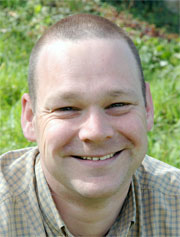Postgraduate supervision
Rob currently supervises/co-supervises the following research student projects:
- Early Humans in Britain: Cultural Adaptations from Coastal to Inland Occupation (with Prof. Nick Ashton & Dr Rob Davis [British Museum], Prof. Simon Lewis [QMUL] & Dr Rob Batchelor).
- How can plant wax analysis contribute to our understanding of the British Pleistocene? (with Dr Stuart Black).
- Behavioural and technological variability in MIS 9 from intra-site to landscape scales (with Dr Alison MacLeod).
Rob is happy to discuss proposals for future postgraduate research in any areas of Palaeolithic archaeology, in particular: Lower and/or Middle Palaeolithic hominin behaviour and lithic technology, GIS applications, and experimental archaeology (esp. focusing on tool use or lithic assemblage taphonomy).
For further information, please contact r.hosfield@reading.ac.uk.
Teaching
Rob teaches the Palaeolithic archaeology of Europe, global human origins, lithics, geographic information systems (GIS), and statistics for archaeologists. He was awarded a University Teaching Fellowship in 2018.
Research projects
Rob's latest book (The earliest Europeans: a year in the life: seasonal survival strategies in the Lower Palaeolithic) explores the European Lower Palaeolithic from the perspective of a 'year in the life' and is freely available at: https://books.casematepublishers.com/The_Earliest_Europeans.pdf
Rob is currently working on a Paleolithic fieldwork project in the Mendips( with colleagues from Exeter, Brighton and Royal Holloway) and is a small part of Martin Bell's new National Geographic- funded project: Mesolithic footprints, fishtraps and settlement in lowland Britain.
Rob co-led (with Dr Rob Batchelor, Dr Hannah Fluck and Dr Chris Green; with case studies provided by key British Palaeolithic archaeologists and Quaternary scientists) a Historic England-funded project, Curating the Palaeolithic, the goal of which was to produce clear and accessible new guidance documents that will advise curators, Local Planning Authorities, consultants and contractors in the management of the Palaeolithic resource. All of the project documents are available at: https://historicengland.org.uk/images-books/publications/curating-the-palaeolithic/ and the project is summarised in this conference poster from Pal-Meso 2024.
Rob recently completed, with Dr James Cole (Brighton University), an AHRC Network project: Coping with climate: the legacy of H. heidelbergensis. This AHRC-funded research network addressed two fundamental evolutionary questions: firstly, what were the ‘globalising’ adaptations of Homo heidelbergensis and other early European hominin species (Homo antecessor and perhaps also Homo erectus), which existed prior to the Neanderthals and our own species, Homo sapiens? Secondly, how have those ‘globalising’ adaptations contributed to the evolution of later species’ abilities (i.e. Homo sapiens and the Neanderthals) to manage climatic and environmental challenges (both past and present)? The project's workshop has led to a virtual special issue in Quaternary Science Review. The project also produced some Palaeolithic (early prehistory) resources for schools: http://blogs.brighton.ac.uk/copingwithclimate/resources-for-schools/
In recent years Rob has completed new papers on handaxe variability ('Less of a bird's song than a hard rock ensemble') with James Cole and John McNabb, the chronology of the Lower Palaeolithic occupation of Europe, with James Cole ('Early hominins in north-west Europe: a punctuated long chronology?'), and palaeoclimatic and palaeoenvironmental patterns in Europe between 550-350,000 years ago ('Variations by degrees: Western European paleoenvironmental fluctuations across MIS 13–11'). Rob’s other significant recent publications are a paper on the challenges of Palaeolithic survival in mid-latitudes (Hosfield 2016), a site monograph on the British Lower Palaeolithic site of Broom (Hosfield & Green 2013), and an edited volume in honour of Prof. Clive Gamble (Coward et al. 2015).
Rob’s other projects have included:
He has also published papers on the early Middle Pleistocene archaeology of Britain, the Lower and Middle Palaeolithic archaeology of the Solent (with Dr Nick Ashton of the British Museum), British Palaeolithic settlement histories (with Dr Ashton and Dr Simon Lewis, Queen Mary’s, University of London), the handaxe assemblage from the British Lower Palaeolithic site of Broom (with Dr Jenni Chambers), antiquarians and the Palaeolithic record, social learning and craft skills, and the interpretation of Palaeolithic assemblages from fluvial contexts.
Rob was involved with the South West Archaeological Research Framework (SWARF), acting as the period convenor for the Palaeolithic and Mesolithic, and has also contributed to the Solent-Thames Archaeological Research Framework (the Lower and Middle Palaeolithic archaeology of Berkshire; Wenban-Smith
et al. 2014) and the Buckinghamshire and Milton Keynes Terrestrial Minerals Resource Assessment.
Journal Articles
- Hosfield, R.T. & Chambers, J.C. (2003) Recent Research at the Broom Lower Palaeolithic Site. Antiquity 77 (297).
- Hosfield, R.T. & Chambers, J.C. (2002) The Lower Palaeolithic site of Broom: geoarchaeological implications of optical dating. Lithics: The Newsletter of the Lithic Studies Society 23: 33-42.
Book Sections
- Hosfield, R.T. (2002) Quantifying the British Palaeolithic: Regional Data and Hominid Adaptations. In D.W. Wheatley, G.P. Earl & S. Poppy (ed's) Contemporary themes in Archaeological Computing: 37-46. Department of Archaeology, University of Southampton Monograph No. 3. Oxbow Books, Oxford.
- Hosfield, R.T. (2001) The Lower Palaeolithic of the Solent: site formation and interpretive frameworks. In F.F. Wenban-Smith & R.T. Hosfield (ed's) Palaeolithic Archaeology of the Solent River: 85-97. Lithic Studies Society Occasional Paper 7. Lithic Studies Society, London.
- Hosfield, R.T. (2001) Approaching a Wider Spatio-Temporal View: Modelling the Terrace Gravel Assemblages. In K.J. Fewster & M. Zvelebil (eds.) Ethnoarchaeology and Hunter-Gatherers: Pictures at an Exhibition: 127-141. British Archaeological Reports (International Series) 955. Archaeopress: Oxford.
Books
Wenban-Smith, F.F. & Hosfield, R.T. (ed's). (2001) Palaeolithic Archaeology of the Solent River. Lithic Studies Society Occasional Paper 7. Lithic Studies Society, London.
